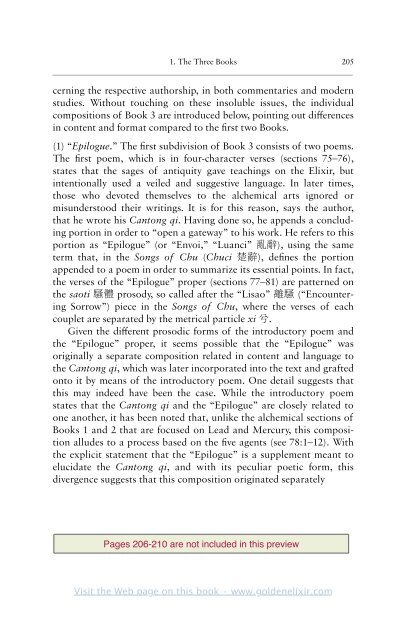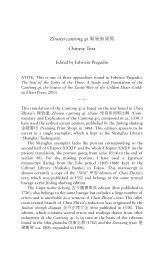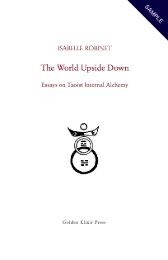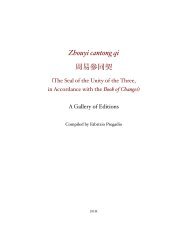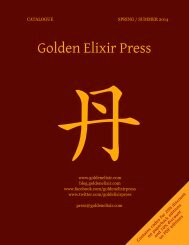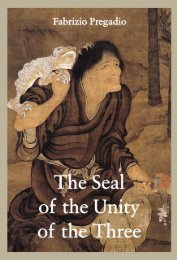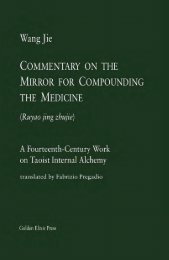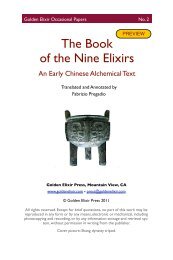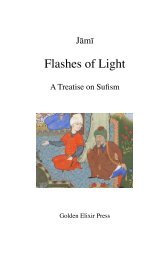The Seal of the Unity of the Three â Vol. 2 - The Golden Elixir
The Seal of the Unity of the Three â Vol. 2 - The Golden Elixir
The Seal of the Unity of the Three â Vol. 2 - The Golden Elixir
- No tags were found...
Create successful ePaper yourself
Turn your PDF publications into a flip-book with our unique Google optimized e-Paper software.
1. <strong>The</strong> <strong>Three</strong> Books 205<br />
—————————————————————————————————————————<br />
cerning <strong>the</strong> respective authorship, in both commentaries and modern<br />
studies. Without touching on <strong>the</strong>se insoluble issues, <strong>the</strong> individual<br />
compositions <strong>of</strong> Book 3 are introduced below, pointing out differences<br />
in content and format compared to <strong>the</strong> first two Books.<br />
(1) “Epilogue.” <strong>The</strong> first subdivision <strong>of</strong> Book 3 consists <strong>of</strong> two poems.<br />
<strong>The</strong> first poem, which is in four-character verses (sections 75–76),<br />
states that <strong>the</strong> sages <strong>of</strong> antiquity gave teachings on <strong>the</strong> <strong>Elixir</strong>, but<br />
intentionally used a veiled and suggestive language. In later times,<br />
those who devoted <strong>the</strong>mselves to <strong>the</strong> alchemical arts ignored or<br />
misunderstood <strong>the</strong>ir writings. It is for this reason, says <strong>the</strong> author,<br />
that he wrote his Cantong qi. Having done so, he appends a concluding<br />
portion in order to “open a gateway” to his work. He refers to this<br />
portion as “Epilogue” (or “Envoi,” “Luanci” 亂 辭 ), using <strong>the</strong> same<br />
term that, in <strong>the</strong> Songs <strong>of</strong> Chu (Chuci 楚 辭 ), defines <strong>the</strong> portion<br />
appended to a poem in order to summarize its essential points. In fact,<br />
<strong>the</strong> verses <strong>of</strong> <strong>the</strong> “Epilogue” proper (sections 77–81) are patterned on<br />
<strong>the</strong> saoti 騷 體 prosody, so called after <strong>the</strong> “Lisao” 離 騷 (“Encountering<br />
Sorrow”) piece in <strong>the</strong> Songs <strong>of</strong> Chu, where <strong>the</strong> verses <strong>of</strong> each<br />
couplet are separated by <strong>the</strong> metrical particle xi 兮 .<br />
Given <strong>the</strong> different prosodic forms <strong>of</strong> <strong>the</strong> introductory poem and<br />
<strong>the</strong> “Epilogue” proper, it seems possible that <strong>the</strong> “Epilogue” was<br />
originally a separate composition related in content and language to<br />
<strong>the</strong> Cantong qi, which was later incorporated into <strong>the</strong> text and grafted<br />
onto it by means <strong>of</strong> <strong>the</strong> introductory poem. One detail suggests that<br />
this may indeed have been <strong>the</strong> case. While <strong>the</strong> introductory poem<br />
states that <strong>the</strong> Cantong qi and <strong>the</strong> “Epilogue” are closely related to<br />
one ano<strong>the</strong>r, it has been noted that, unlike <strong>the</strong> alchemical sections <strong>of</strong><br />
Books 1 and 2 that are focused on Lead and Mercury, this composition<br />
alludes to a process based on <strong>the</strong> five agents (see 78:1–12). With<br />
<strong>the</strong> explicit statement that <strong>the</strong> “Epilogue” is a supplement meant to<br />
elucidate <strong>the</strong> Cantong qi, and with its peculiar poetic form, this<br />
divergence suggests that this composition originated separately<br />
Pages 206-210 are not included in this preview<br />
Visit <strong>the</strong> Web page on this book • www.goldenelixir.com


